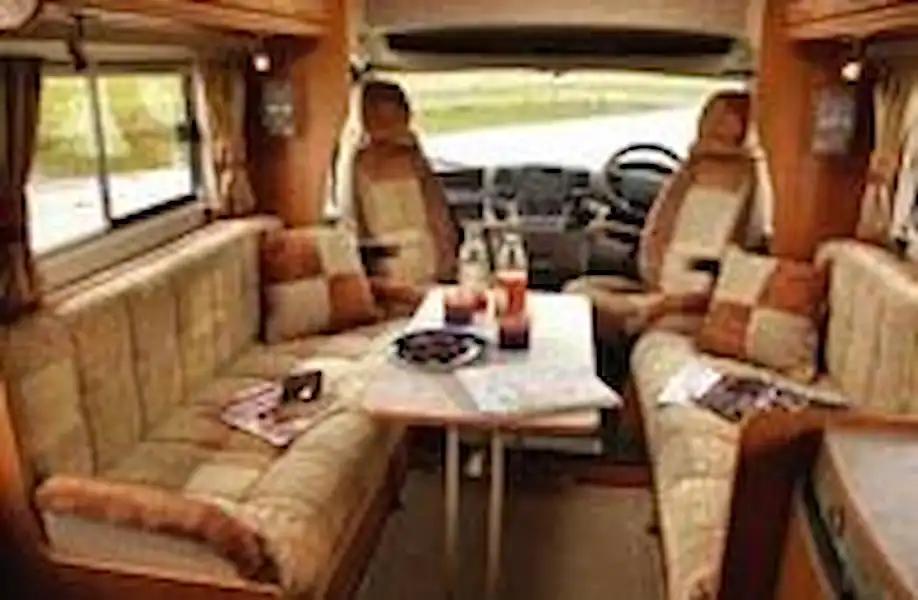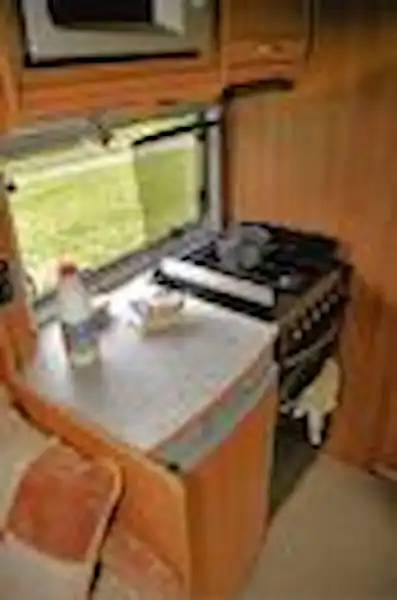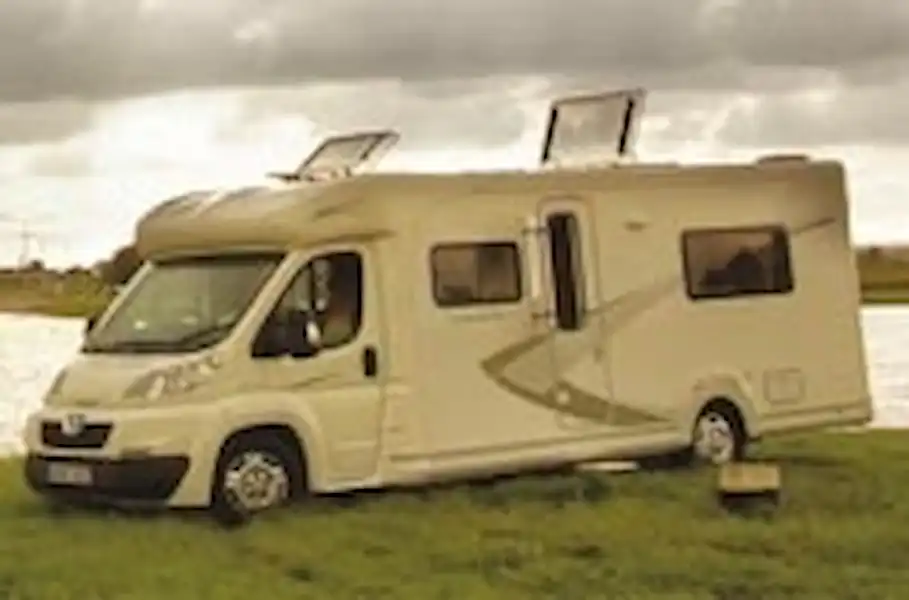Key Features
| Model Year | 2004 |
| Class | Overcab Coachbuilt |
| Base Vehicle | Peugeot Boxer |
| Engine Size | 2.0TD |
| Berths | 4 |
| Main Layout | Rear Lounge |
At a glance
Full review
In short, it’s not for anyone who is faint of heart. Or short of driveway. For the sort of test we had in mind, however, it was pretty much spot on.
We needed something that could take huge bites out of several mainland European countries in a single day en route to the annual über-motorhome show at Düsseldorf, and provide spacious, comfortable and entirely self-contained living for two for a week in the exhibition centre’s grounds, probably without benefit of electric hook-up.
The Augusta ticked all these boxes, with its twin single beds (this was going to be an all-blokes trip), range-topping engine and seemingly never-ending interior layout further points in its favour.
The motorhome world has had over a year, now, to get used to Peugeot’s thoroughly avant-garde new-shape Boxer (and, indeed, its all-but identical Fiat Ducato and Citroën Relay siblings).
Elsewhere, little touches like the twin ice-white LED running lights either side of the overcab moulding (the rear lights are super-bright LEDs too) and bonnet stickers whose curves flow into the headlights give the big Augusta a personality that’s refreshingly different to the norm.
But you might feel, with some justification, that standard-fit alloy wheels should form part of a package that will relieve you of more than £50,000.
Design glitches? Well, the low-line chassis really must be super-low if the position of the side exhaust relative to the road is anything to go by: manoeuvring the big Autocruise on grassy surfaces during our many photo sessions saw the pipe disappear regularly (if painlessly) into the undergrowth; while one particularly vicious sleeping policeman somewhere in rural Holland managed to make wince-inducing contact with it.
The boxy fuel filler flap (which, in the Augusta’s defence, it shares with not a few other Sevel-underpinned motorhomes) feels a bit loose and flimsy, too, although at least the cap itself can be locked, even if the covering flap cannot.
Some motorhomes impress you with their innate style or build-quality. Others do it through their attention to design minutiae or clever engineering, while a few just seem to push the envelope just that little bit further than anyone else.
The Augusta pushes quite a few of these buttons, but what really sags your jaw when you climb aboard is the sheer size of it. Really and truly, the thing seems to go on forever.
Up front, the step in the lounge (which I managed to fall both up and down more times than I care to remember) near the kitchen betrays the position of the twin leisure batteries stashed away beneath the lounge floor.
Further back, there’s a door that leads into the bedroom, where you’re faced by a pair of permanent longitudinal single beds, each equipped with a dinky little headboard, a pair of reading lights (those at the foot end of the bed presumably being so your toes can catch up with the latest Harry Potter book) and a small tambour-door wardrobe.
And out back, there’s yet another door, this one leading into the narrow, but surprisingly spacious nonetheless end washroom, complete with separate shower and a shallow wardrobe.
Which by my book makes this a motorhome with fully four rooms, two of which are entirely self-contained. Small wonder that bodyshell is so long.
Lounge first, and while there’s quite clearly nothing wrong with having a simple pair of inward-facing settees allied to a pair of swivelling cab seats as per here, it smacks just a tiny bit of a lack of design imagination in these enlightened days of even sub-£30,000 van conversions sporting settees that double up as chaises longues and/or travel seats.
Fair enough, the Augusta is almost certain to be bought by retired couples rather than young families, but this layout could have been every inch the family friend had it stretched to an extra pair of travel seats – an option that is possible by specifying a half-dinette on the offside in place of the second settee.
As tested, there’s room enough up front for four (or up to six, if the cab seat occupants can reach the table) adults to dine in comfort, so no worries there.
The good news is that each settee is perfectly comfortable, with ample natural lighting by day (thanks in the main to the large crank-operated panoramic rooflight), an embarrassment of electric lighting by night (including a pair of novel bulkhead-mounted touch-control mains lights) and a fabric that, while hardly likely to set pulses racing, is unlikely to offend anyone either.
The surrounding cabinetry is of a high standard, too, and while the lack of any transit catches disappoints, at least the doors themselves sport simple dampers to prevent them rattling when on the move.
Anyone hoping to find a Wentworth-style king-sized kitchen within the Augusta’s considerable interior might be disappointed to learn that the former’s clever swing-out cupboard and 150-litre true fridge/freezer are sadly missing from the latter.
That said, the Augusta’s galley is decent enough for the vehicle’s intended market of couples, and while the worktop space to the left of the dual-fuel cooker isn’t exactly over-generous, it’s slightly better than average and big enough to hold a couple of pans or chopping boards.
Equipment extends to a Baraldi extractor fan (which brings with it an extra pair of downlighters) plus a Spinflo cooker and Dometic fridge.
It’s reassuring to know that you can still boil a pan on the electric hotplate even if your gas supply runs out unexpectedly, too, while fast food addicts will no doubt approve of the 800W microwave oven ensconced herein.
As with many such installations, however, its elevated position does mean you need to take extra care when extracting piping hot liquid foodstuffs from it. Shorter chefs need not apply.
Unusually, the kitchen sink unit sits remote from the galley proper across the axle by the main entrance door.
There’s no worktop space here at all unless you fold down the sink cover (in doing so putting the sink out of bounds) or erect the extension flap to the left of the sink (in doing so blocking access to the bedroom and washroom beyond).
The good news here is that storage space is better than average, with a good-sized low-level cupboard, a pair of drawers above and decent roof locker at eye level.
Star of the washroom has to be that large separate shower cubicle. I brandished the loofah in there at least once a day, every day, and enjoyed strong riser pressure and deliciously piping hot water (courtesy of the Alde system) every time.
Given that our test vehicle was an early production model with just a handful of miles on the clock, its track record during our week-long test turned out to be pretty impressive – as we’ve come to expect from Autocruise ’vans.
A full version of this review first appeared in the November 2007 issue of Which Motorcaravan. To subscribe to the magazine, click here.
Expert motorhome advice to your door!
Why not subscribe to one of our fabulous magazines and get expert advice, travel ideas, technical help and all the latest news for your motorhome and your motorhome adventures!
Want to know more about MMM magazine?
Every month MMM has articles written by motorhomers who have been there and done it, from great UK and European (and further afield) tours, campsite reviews, owners' reports and DIY projects among other things. MMM's tests, reviews and expert buying guides are not to be missed. MMM's technical advice is a must and includes everything from weekend jobs to longer-term DIY projects. And much more!
About MMM magazineWant to know more about What Motorhome magazine?
Every issue of What Motorhome magazine provides essential buying advice for anyone looking to buy a new motorhome or campervan or upgrade their existing model. With a pedigree of over 30 years of offering the best motorhome and campervan buying advice, every issue of What Motorhome includes more new motorhome and campervan reviews than you will find in any other magazine.
About What MotorhomeWant to know more about Campervan magazine?
Campervan is the exciting monthly magazine that will give you all the inspiration you need to explore the world in your campervan. Every issue is packed with real-life campervanning experiences, inspiring travel ideas in the UK and further afield, the best campsites to stay on, campervan road tests and reviews of the latest models, and much more!
About Campervan magazine














